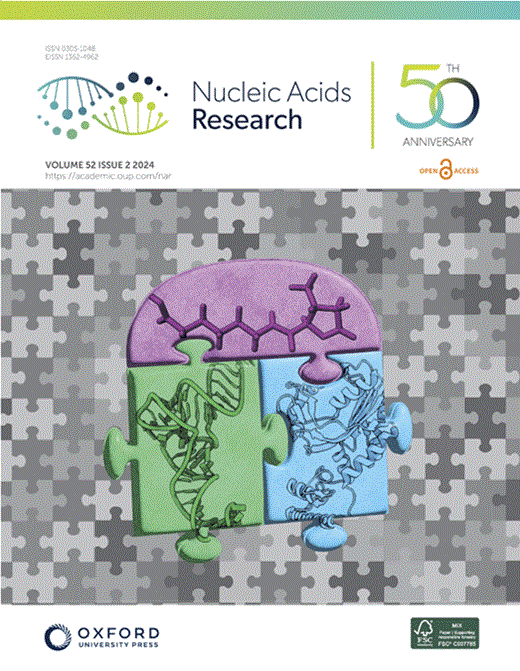在逆境条件下,小蛋白B对细胞形态的重塑增强了维氏气单胞菌的抗逆性和定植能力
IF 13.1
2区 生物学
Q1 BIOCHEMISTRY & MOLECULAR BIOLOGY
引用次数: 0
摘要
病原体通常表现出形态可塑性,以承受环境压力,并在复杂的宿主免疫环境中茁壮成长。在这项研究中,我们证明了维罗尼气单胞菌的形态适应性,这是一种具有广泛环境分布的严重病原体。我们的研究结果证实了小蛋白B (SmpB)在形态适应中的关键作用,并揭示了ArgR介导的保守的双安全调控机制。在不同的环境条件下,维罗妮草的形态发生了变化,抗逆性增强。我们确定了反翻译成分SmpB对这种形态适应至关重要,独立于其在反翻译中的规范作用。此外,SmpB转录上调肽聚糖生物合成基因。卷积神经网络模型预测ArgR是smpB的转录调节因子。随后的生化分析证实ArgR直接与smpB启动子结合,并通过隔离RNA聚合酶抑制其转录。此外,ArgR和SmpB之间的相互作用促进了ArgR对SmpB启动子的亲和力。在小鼠感染模型中,smpb介导的形态重组增强了维罗氏单胞杆菌的肠道定植和毒力。总之,我们的研究揭示了一个新的机制,SmpB与ArgR在一个负反馈回路中工作,调节细胞壁合成并增强细菌的生态适应性。这些对宿主-病原体相互作用的见解为创新的抗菌治疗和诊断策略确定了有希望的靶点。本文章由计算机程序翻译,如有差异,请以英文原文为准。
Rewiring of cell morphology by Small protein B enhances stress tolerance and colonization in Aeromonas veronii under adverse conditions
Pathogens often display morphological plasticity to withstand environmental stress and thrive in complex host immune environments. In this study, we demonstrated the morphological adaptation of Aeromonas veronii, a severe pathogen with a wide environmental distribution. Our results establish the critical role of Small protein B (SmpB) in morphological adaptation and reveal a conserved dual-safety regulatory mechanism mediated by ArgR. A. veronii exhibited morphological changes and gained enhanced stress resistance in response to environmental cues. We identified the trans-translation component SmpB as critical for this morphological adaptation, independent of its canonical role in trans-translation. Furthermore, SmpB transcriptionally up-regulates peptidoglycan biosynthesis genes. A convolutional neural network model predicted ArgR as a transcriptional regulator of smpB. Subsequent biochemical assays confirmed that ArgR directly bound to the smpB promoter and repressed its transcription by sequestering RNA polymerase. Moreover, the interaction between ArgR and SmpB promoted the affinity of ArgR for the smpB promoter. SmpB-mediated morphological rewiring enhanced A. veronii’s intestinal colonization and virulence in a mouse infection model. Collectively, our study reveals a novel mechanism in which SmpB, operating in a negative feedback loop with ArgR, modulates cell wall synthesis and enhances bacterial ecological fitness. These insights into host–pathogen interactions identify promising targets for innovative antimicrobial therapies and diagnostic strategies.
求助全文
通过发布文献求助,成功后即可免费获取论文全文。
去求助
来源期刊

Nucleic Acids Research
生物-生化与分子生物学
CiteScore
27.10
自引率
4.70%
发文量
1057
审稿时长
2 months
期刊介绍:
Nucleic Acids Research (NAR) is a scientific journal that publishes research on various aspects of nucleic acids and proteins involved in nucleic acid metabolism and interactions. It covers areas such as chemistry and synthetic biology, computational biology, gene regulation, chromatin and epigenetics, genome integrity, repair and replication, genomics, molecular biology, nucleic acid enzymes, RNA, and structural biology. The journal also includes a Survey and Summary section for brief reviews. Additionally, each year, the first issue is dedicated to biological databases, and an issue in July focuses on web-based software resources for the biological community. Nucleic Acids Research is indexed by several services including Abstracts on Hygiene and Communicable Diseases, Animal Breeding Abstracts, Agricultural Engineering Abstracts, Agbiotech News and Information, BIOSIS Previews, CAB Abstracts, and EMBASE.
 求助内容:
求助内容: 应助结果提醒方式:
应助结果提醒方式:


